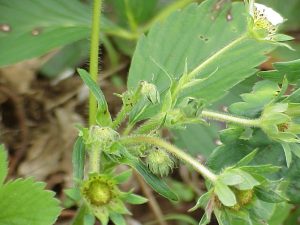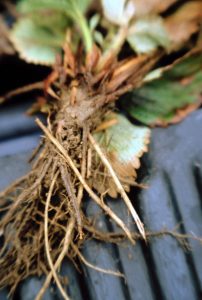Strawberry IPM Newsletter No. 3 – May 26, 2023
TWO SPOTTED SPIDER MITES REACH DAMAGING LEVELS
Very Low Numbers of Tarnished Plant Bug and Clippers

Situation: While visiting strawberry fields around the state this week, I was impressed with how well growers had protected strawberry flowers from the hard frost event last week. Most of the damage I saw was actually from an unexpected frost back in early May. So, in spite of that frost last week the crop in most fields still looks good. Insect pests remain at very low levels this week, but mite populations have risen to damaging levels in some fields. There was also very little disease symptoms noted on the foliage, but we continue to be alert for problems because the rain and irrigation we have experienced lately can trigger fungal infections.
Strawberry bud weevil: We have found very little clipper injury this season, with only one field over the control threshold of 1.2 clipped buds per two feet of row. Early blooming varieties may already be past the development stage when clippers can cause significant harm. Once the primary and secondary flowers on a truss have opened it is unlikely that clippers will cause economic damage. Growers with fields still coming into bloom on later varieties should remain on the lookout for clipped buds.
Tarnished plant bug: We have started finding small tarnished plant bug nymphs in some strawberry fields, but the populations have not yet reached the control threshold. With the onset of warmer weather, we expect plant bugs to become more active in fields soon. It is important to scout for them regularly, as they may appear very quickly once the weather does improve.
Two-spotted spider mites: Spider mite numbers have been increasing at some locations this week, and were over the spray threshold of 25% of leaves infested in two southern Maine fields. This means that you should start scouting for mites now if you haven’t already.
Diseases: Most fields are still in the early to late bloom stage, which is the period for protecting against gray mold. With intermittent rain, heavy dews and irrigation events in the past two weeks, conditions are good for Botrytis spores to be infecting strawberry flowers. Two to three sprays of fungicide during bloom will usually provide good protection against gray mold. However, if a field receives more than one inch of rain or irrigation after a fungicide application, it is likely no longer effective and another application should be applied if the blossoms are still at a susceptible stage.

Red stele root rot: We have seen mild symptoms of red stele in two fields over the past two weeks. Infected plants appear weak and stunted with small leaves that may have a faded bluish color. Cutting the roots of infected plants will reveal a dark red core instead of the usual healthy white. Symptoms typically appear first in the lower, poorly drained areas of a field. With the wet, cool soil conditions this spring, infections were likely. However, symptoms appeared very late and should conditions become warm and dry, there shouldn’t be much further spread this year. If infested fields are going to be carried over, an application of Ridomil Gold®, Aliette® or Phostrol® should be applied in the fall. Foliar sprays of Aliette® or Phostrol® can still be applied this spring.
Leaf spot and leaf scorch have been seen at low levels in some fields over the past two weeks, usually on the lower, older foliage. Purple spots on the leaves with white centers characterize leaf spot, while small, dark red spots indicate leaf scorch. Younger foliage may become infected and cause the plants to weaken, if left untreated. Fungicides applied to manage gray mold may also provide control of leaf spots, including Captan®, Mervion® and Pristine®.
Spring Fertilizers: With many fields experiencing a deluge in April and many irrigation events in May, growers may be concerned about fertility levels in the soil. Typically, we recommend being conservative with spring nitrogen applications to prevent excessive vegetative growth, soft fruit and gray mold. Depending upon soil type and history, 15 to 30 lb. of actual nitrogen per acre is usually adequate to promote good early growth. However, if plants appear yellow or reddish in color and have short petioles (leaf stems), they may benefit from a light nitrogen application. If you have already applied nitrogen this spring, keep the supplemental rate low (10-20 lb.) If you haven’t applied nitrogen, a heavier application may be more effective (20-30 lb.). Calcium nitrate (15.5% Ca) is a good source of available nitrogen and also supplies calcium, which can be helpful in fruit development.
Boron applications in the spring can also be helpful in promoting good pollination and early fruit development. However, boron in high amounts can be toxic to the plants. One to two pounds of actual boron per acre is usually adequate to meet the needs of strawberry plants, often applied as a foliar spray of Solubor® (20% B).
Grass control in strawberry fields: Controlling perennial grasses in strawberry beds can be challenging. Poast®, Select 2EC® and Selectmax 0.97EC® are registered to control emerged grasses in strawberries. Often more than one application is needed to obtain satisfactory control. All of these products require the addition of a surfactant to the spray tank. If crop oil is used for this role, it is important to note that it may cause significant injury to strawberry plants if applied on a hot, humid day, or when high temperatures occur within one or two days of application. Poast® should not be applied within 7 days of harvest. Select® and Selectmax® should not be applied within 4 days of harvest. Follow all product label instructions.
Spring Growers’ Twilight Meeting: The Maine Vegetable & Small Fruit Growers Association will be having a Spring Twilight Meeting on Tuesday, June 6, at 5:30 pm at Stevenson’s Strawberries, 271 Tucker Road in Wayne. The Stevenson’s specialize in strawberries but also grow a wide variety of vegetables for their stand and CSA.
The latest edition of the 2022-2023 New England Small Fruit Management Guides is available.
Sincerely,
David T. Handley
Vegetable & Small Fruit Specialist
Highmoor Farm
P.O. Box 179
Monmouth, ME 04259
207.933.2100
Pest Management Unit
17 Godfrey Dr.
Orono, ME 04473
1.800.287.0279
Where brand names or company names are used, it is for the reader’s information. No endorsement is implied nor is any discrimination intended against products with similar ingredients. Always consult product labels for rates, application instructions and safety precautions. Users of these producers assume all associated risks.
The University of Maine is an equal opportunity/affirmative action institution.
